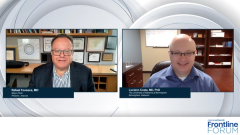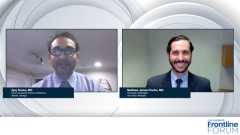
Comparison of Results from the MAIA and SWOG0777 Studies
Rafael Fonseca, MD, describes key data from the MAIA and SWOG 0777 studies investigating triplet regimens in multiple myeloma treatment, and how the results compare.
Luciano Costa, MD, PhD: Rafael, I know you have of course been very involved in doing a very in-depth analysis of those studies, so, when you think about particularly our reality, how do you think the results, for example from the MAIA SWOG 0777. Now we have those two regimens that are triplets, they are very popular, very well known, and often times we - I struggle with decide which one to apply for a patient. So, how do you compare those results?
Rafael Fonseca, MD: Thank you, that's great, Luciano. By the way, I agree with everything you were saying.
For the audience, it might seem daunting sometimes when you think, boy, we have all this many clinical trials and this approvals, but the reality, at the end of it all, things get simple because the best rises to the very top and that’s exactly how you closed, I think, as you stated, I'm going to exclude the ALCYONE study for further discussion since we don't use that in the United States. So, mostly the options are MAIA and SWOG and SWOG of course builds on the familiarity that practicing oncologist have had Revd. and both MAIA and SWOG are represented in the treatment guidelines, for instance, the NCCN guidelines. Both of them have category 1 level evidence that they are effective, so, they're supported by those guidelines as such. Now, I think we still have to ask ourselves, 'what is the next step?' and obviously - and I'll talk more about this a little bit later, but obviously the way to address this is with a perspective randomized comparison. But part of the situation right now is, can we make some decisions based on the indirect information we have for both clinical trials? One of the things with the SWOG, so, and I think this is so important, the SWOG trial was done in patients who didn't have the transplant as first intent. And there were some patients who were over 65 and under 65 and the results appeared to be clearer in the separation of curves for those patients under 65, so, we need to think about this, how these plays in patients over 65. And importantly, a common regimen that people make reverence to is this RVD-lite, which RVD-lite of course can work. Many regimens work, melphalan prednisolone works, but if you start with a triplet that perhaps becomes a little bit diminished in efficacy because you do lower doses, which is sometimes absolutely necessary for treatment of patients, you still have to ask the question of efficacy and duration of the trials. So those are some of the things that need to be compared. We recently did a simulation, I'll talk about this a little bit later, but trying to see if by what's available right now, we can make some inferences about the best regimen for our patients. And I - one of the other aspects that I think is critically important is to me that in the elderly population, one of the key toxicities of course of bortezomib is peripheral neuropathy. But peripheral neuropathy can also have other clinical manifestations such as imbalance, falls, there's even some work on hearing. So, just like that, and just like we think about daratumumab, and we think about, 'what might be some of the effects on perhaps immunity, we need to balance those two things out. But that's kind of where we are and that's a background that takes us to where the two regimens that are being used the most are both MAIA and the SWOG 0777, which again has RVD for the elderly.
Newsletter
Stay up to date on recent advances in the multidisciplinary approach to cancer.




















































































